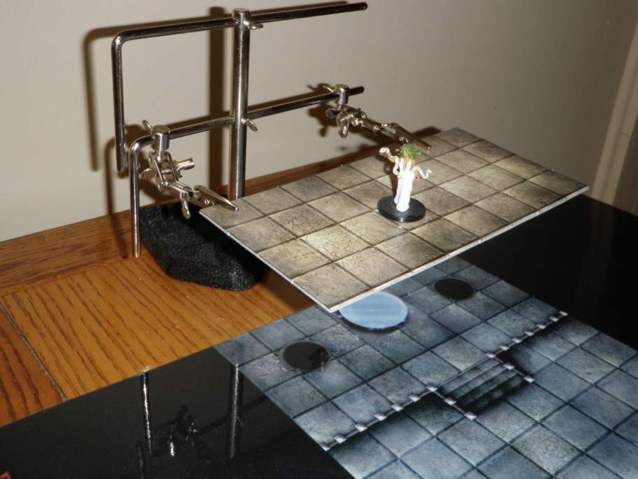In “Battle maps take over Dungeons & Dragons,” I wrote about how the widespread introduction of battle maps can improve the fun of combat encounters. Everyone knows where everything is. The game never gets bogged down with boring descriptions of layout and dimensions.
Nonetheless, as much as the simple map avoids confusion, it suffers two weaknesses where I still search for improvements.
Elevation
Without 3D terrain, battle maps do a poor job of representing elevation, and cannot clearly represent rooms with multiple, overlapping levels, such as balconies.
When I create my own adventures, the limits of the flat map limit the kind of spaces that I imagine. So sometimes I work to break the constraints of the map. For example, I once ran a vertical dungeon, perched on walkways and platforms carved into—and jutting out of—a giant cliff. While this kind of environment can inject some fresh wonder into the game, I’m always annoyed when an encounter forces, say, a balcony into an essentially static combat. If an encounter adds the complexity of multiple levels, I want a dynamic encounter with characters on the move between levels, trading fire and flying around. If you have levels, force the characters to go to them before they clear the room.

I want to find some convenient brackets or holders that raise dungeon tiles over the battlefield as with my improvised balcony in the photo. Ideal holders would be compact enough to fit in my convention bag, but heavy enough to stay put. Do any MacGyvers out there have suggestions?
Lighting and visibility
Someday, I hope we all have touch-sensitive, electronic battle maps that sense and track the presence of a particular miniature in a particular spot, and automatically reveal the parts of the cave that that the players can see. Until then, dealing with lighting and line of sight is a chore that I too often gloss over. Some methods help. You can reveal the map as the players explore, either by lifting coverings, laying new tiles, or just drawing as needed. However, in a big battle, where some combatants lurk in the darkness, the matter of tracking who sees what becomes unwieldy. When does lighting become worth tracking? Does anyone have any tricks for handling lighting and visibility?
Nonetheless, as much as the simple map avoids confusion, it suffers two weaknesses where I still search for improvements.
Elevation
Without 3D terrain, battle maps do a poor job of representing elevation, and cannot clearly represent rooms with multiple, overlapping levels, such as balconies.
When I create my own adventures, the limits of the flat map limit the kind of spaces that I imagine. So sometimes I work to break the constraints of the map. For example, I once ran a vertical dungeon, perched on walkways and platforms carved into—and jutting out of—a giant cliff. While this kind of environment can inject some fresh wonder into the game, I’m always annoyed when an encounter forces, say, a balcony into an essentially static combat. If an encounter adds the complexity of multiple levels, I want a dynamic encounter with characters on the move between levels, trading fire and flying around. If you have levels, force the characters to go to them before they clear the room.

I want to find some convenient brackets or holders that raise dungeon tiles over the battlefield as with my improvised balcony in the photo. Ideal holders would be compact enough to fit in my convention bag, but heavy enough to stay put. Do any MacGyvers out there have suggestions?
Lighting and visibility
Someday, I hope we all have touch-sensitive, electronic battle maps that sense and track the presence of a particular miniature in a particular spot, and automatically reveal the parts of the cave that that the players can see. Until then, dealing with lighting and line of sight is a chore that I too often gloss over. Some methods help. You can reveal the map as the players explore, either by lifting coverings, laying new tiles, or just drawing as needed. However, in a big battle, where some combatants lurk in the darkness, the matter of tracking who sees what becomes unwieldy. When does lighting become worth tracking? Does anyone have any tricks for handling lighting and visibility?

